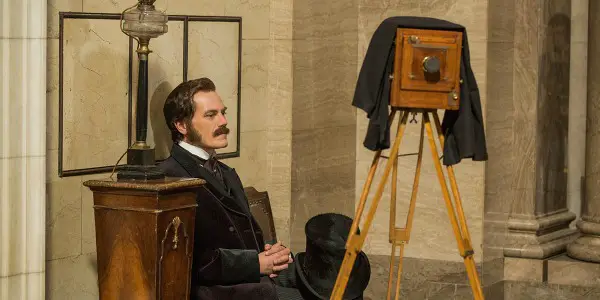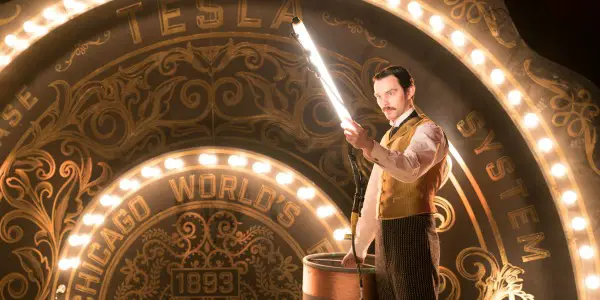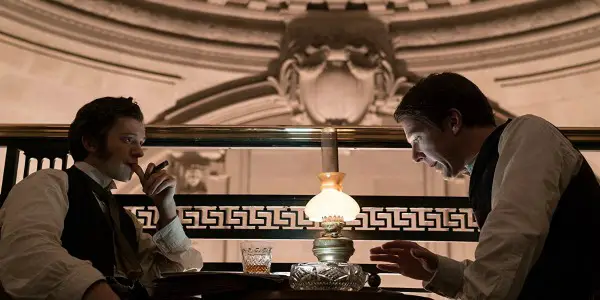THE CURRENT WAR: DIRECTOR’S CUT: Gomez-Rejon’s Visually Masterful Biopic Analyzes The Cost Of Progress

Alex Arabian is a freelance film journalist and filmmaker. His…
The over two-year limbo between The Current War‘s previous cut’s premiere at the 42nd annual Toronto International Film Festival (TIFF), on September 9, 2017, and the Director’s Cut‘s U.S. release, on October 25, 2019, was entirely worth the wait. Director Alfonso Gomez-Rejon has delivered another aesthetically striking feast for the eyes following his sophomoric narrative feature directorial effort Me and Earl and the Dying Girl. This project, produced by Martin Scorsese, Steven Zaillian, Benedict Cumberbatch, and Bob and Harvey Weinstein, provides the auteur with considerably more physical and intellectual resources to work with at the helm than he’s had in his career. Still, he’s kept much of his creative team from Me and Earl and the Dying Girl, and it shows.
The Current War was buried after Weinstein was buried by the New York Times (Weinstein was in the middle of overseeing the film’s editing process when the New York Times published the first story of the sexual assault allegations against him). In a state of panic, the now-dissolved Weinstein Co. sold the project to Lantern Entertainment, who would eventually sell the film’s U.S. distribution rights to 101 Studios. After Weinstein rushed the film for TIFF’s release, obliterating the intended result of the fluid editing process that Gomez-Rejon developed with David Trachtenberg in Me and Earl and the Dying Girl, Scorsese, ever the film preservationist, saved the film, ensuring Gomez-Rejon‘s vision was realized.
The end result is a gorgeous, fascinating, well-acted, hybridized biopic, thriller, and drama, if slightly narratively hasty.
A “Surreal & Traumatic” Journey
Before his downfall, everyone knew of Weinstein’s notorious, incessant need to have the final edit over certain films of actual artists (far more intelligent than he is) he produces, overstepping his boundaries. There are plenty of examples of this type of behavior in the past. Gomez-Rejon was prepared to be a “yes man” when it came to Weinstein’s editing process in order to avoid any conflict of egos when Weinstein urged the director to re-cut the film for its TIFF premiere. “I knew in my heart, and every fiber of my body was saying, ‘it’s not ready.'” Gomez-Rejon told Deadline. “I went in fearless and then suddenly you realize you are a casualty, a footnote…I could see battles I’d won and all that I lost in the negotiations to keep moments I was proud of. And I could see that there was too much negotiation and compromise on the screen. It felt off, and I found myself wondering if this was the film I would have to make excuses for my entire career, because the story had so much potential.”

Gomez-Rejon would not have to worry about this film being a blemish on his filmography thanks to a particular clause in his contract with The Weinstein Co. that gave Scorsese final cut rights in the event of a disagreement between the studio and director (a highly likely occurrence, in retrospect, although Gomez-Rejon didn’t initially anticipate he would actually need to call upon Scorsese). Riding in like knights in shining armor, Scorsese, his mentor, and to whom Gomez-Rejon was an assistant during the nascent stages of his career, and Scorsese‘s longtime collaborator Thelma Schoonmaker (Raging Bull, The Aviator, The Departed), saved the film when 101 Studios announced it as part of its distribution slate in 2019. By releasing an unfinished film without Scorsese‘s “final cut,” Gomez-Rejon‘s contract with The Weinstein Co. was not being honored. Essentially, Scorsese put the creative power back in Gomez-Rejon‘s hands, providing him suggestions on edits, when prompted, through Schoonmaker‘s peerless co-execution.
Scorsese and Schoonmaker‘s imprints are abundant in every frame of The Current War, much to the film’s credit. Before finding out of Schoonmaker‘s involvement after my viewing, I knew she had to have been involved in some capacity if Scorsese had a creative hand in this. Her editing style is all over it. Much like Scorsese, Gomez-Rejon‘s camera execution demands the viewer’s attention, often using the camera as a tool to mimic where one’s head might rotate along with the focal point of a given scene as if they were immersed in the moment. Bold camera angles, fast-cut, stylized montages, impeccable period detail. This was never a film to be tampered with by someone who knows nothing about the craft. In many ways, The Current War harkens back to the 197os, Hollywood’s second Golden Age, when visual daringness didn’t mean compromising narrative ambitions.
Recapturing The Essence Of The Story
Straightforward but captivating, Michael Mitnick‘s (The Giver) script initially focused on Serbian immigrant Nikola Tesla (Nicholas Hoult) as the moral catalyst between the intense race between inventor Thomas Edison (Cumberbatch) and industrialist George Westinghouse (Michael Shannon) to be the first to power the world with light through electricity. Weinstein’s “vision” aimed to eliminate that character, thus weakening the context for the war of currents that this film intended to focus on; when a lynchpin is removed, the wheel slides off its axis and the mechanism falls apart. There were other edits left on the cutting room floor that Scorsese and Schoonmaker insisted Gomez-Rejon and Trachtenberg place back within the film to strengthen the character development between Edison and Westinghouse, including a Civil War storyline told through flashbacks and a tense scene with Edison consulting on the first iteration of the electric chair.

The Current War would not look as beautiful as it does if it weren’t for cinematographer Chung-hoon Chung‘s inspiring work with the camera. In particular, he emulates an effect created by Oscar-winning cinematographer Roger Deakins (Blade Runner 2049) by a couple of in-camera, makeshift lenses, coined “Deakinizers.” To accentuate the period piece, this creates an almost clouded vision by blurring the edges of the frame to emulate the image of hazy memories or to evoke the feeling a fading photograph, its chemical compounds worn by the sun’s UV rays, its color evaporating around the edges.
Assuming one doesn’t recreate this effect in post-production, they’d need to take the front element off the lens that they’re using, or they could mount the glass of old wide-angle lenses to an Arri Macro, or, for a differing magnitude of the vignetting effect, varying lenses. As Deakins claims, “Removing the front element makes the lens faster, and it also gives you this wonderful vignetting and slight color diffraction around the edges.” A film much more brightly lit than Deakins and Andrew Dominik’s Assassination Of Jesse James By The Coward Robert Ford, The Current War explores the technique against a more vibrant color palette, taking Deakins‘s trick to new and exciting heights.
Interestingly, The Current War‘s vision was recaptured with a runtime 10 minutes quicker than the TIFF cut. “The heart of the film is restored.” Gomez-Rejon told Deadline. “There are new scenes with Tesla, who was never meant to be a lead character but now you see his genius and vulnerability. He doesn’t feel forgotten in this movie, and he gives heart and clarity to the clash between these two men and what drives them to go to such dark places. It’s difficult to imagine the film without Tesla in it. He is described as a futurist, and, really, acts as the super-ego, unwittingly buffering the spiraling ids and egos of Edison and Westinghouse.
The War Of The Currents
Edison and Westinghouse were both originally driven by a desire to be the first to accomplish something great. Edison, an obsessive, brilliant, albeit stubborn man, further motivated by the untimely death of his wife, Mary (Tuppence Middleton), will resort to anything to win. In perpetual regret for not investing enough time as it pertained to his personal life, he continues to focus all of his negative energy toward his inventions. What Westinghouse, a man more characteristically humble in his accomplishments than Edison, lacks for in technical genius compared to Edison and Tesla, he makes up for in business acumen, entrepreneurial drive, and cunningness. He has seemingly endless resources and is more profit-driven than Edison yet. With his wife, Marguerite (Katherine Waterston), an equal partner in his venture, Westinghouse has a moral upper hand. Edison temporarily loses sight of what’s important. Why he’s fighting this war in the first place. To not only provide for his family, but to advance humankind forward.
Enter Tesla, driven by his own ideals for a better future. Although not technically a socialist, Tesla embraced many socialist ideologies. He envisioned a future where energy and profit would eventually be separate from one another. Where science could be explored for the sake of scientific advancement, not constricted by the obligation make a profit for somebody else. Case in point: the Niagara Falls project. The first hydroelectric power plant, Tesla eidetically conceived powering the entire East Coast of the United States by simply harnessing the kinetic energy of the waterfalls of Niagara Gorge in his mind before flawlessly executing the plan. Sure, it was the most cost-effective, appealing option to Westinghouse and, ultimately, the board of the World’s Fair: Columbian Exposition in 1993, but it was also a renewable energy. Tesla had the greater good in mind. By 1920s, 25% of the U.S. ran on hydroelectric power. When putrid avarice followed the Second Industrial Revolution, the burning of fossil fuels proved to be the most financially beneficial to the individual. Alas, in 2015, only 6.1% of the United States ran on hydroelectric power. Much to what would have been Tesla’s horror, our society has chosen wealth over the wellbeing of our planet.

In The Wrong Hands…
In the middle of this battle between high-voltage alternating current (AC) and low-voltage direct current (DC) electriciy, a further subplot is developed, highlighting another unflattering consequence of the blind pursuance of technological and human advancement: the development of the electric chair as a result of the AC technology. Wherever one stands on the morality issue, the intention of harnessed electricity, when Edison, Westinghouse, and Tesla pursued it, was not to cause destruction. The “invention” and subsequent honing of electricity created several moral grey areas. The electric chair was one of the earliest examples of how this creation, meant to improve the lives of the human race, can be used to end a human life.
While Edison and Westinghouse wage war against each other, Tesla engages in a battle of wits and brawn against a far more formidable force: Mother Nature. We have many a monument of past ages; we have the palaces and pyramids, the temples of the Greek and the cathedrals of Christendom,” Tesla said during the Opening Ceremony of the Niagara Falls power plant. “In them is exemplified the power of men, the greatness of nations, the love of art and religious devotion. But the monument at Niagara has something of its own, more in accord with our present thoughts and tendencies. It is a monument worthy of our scientific age, a true monument of enlightenment and of peace. It signifies the subjugation of natural forces to the service of man, the discontinuance of barbarous methods, the relieving of millions from want and suffering.” How ironic, then, that by implanting the idea in the minds of the citizens of our profit-driven society that energy is an industry, we’ve caused global warming in merely three generations since the aftermath of the Chicago World’s Fair. When does irony turn to tragedy? Perhaps when we realize that nature can never be subjugated. It will always fight back and prove itself victorious over the helpless will of man.
Conclusion: Well Worth The Wait
Although it can seem to rush through some of its subplots such as Edison’s dark path down the consultation of the electric chair, his relationship with his family and secretary, Samuel Insull (Tom Holland), Westinghouse’s Civil War backstory, and the importance of the World’s Fair, The Current War is still an impressive technical and creative achievement. Don’t be surprised if you find yourself moved by Gomez-Rejon and Chung‘s visuals alone. Gomez-Rejon manages to almost outdo himself with another celluloid-dedicated, penultimate scene, recreating the magic of the World’s Fair: Columbian Exposition in Chicago with a sequence of breathtaking vignettes. The Current War builds upon a solid narrative foundation by richly transporting the viewer to a pivotal and prescient time for humankind, offering one-of-a-kind insights into some of the most brilliant minds of the 19th and 20th centuries.
Who did you empathize most with in The Current War? Who gave your favorite performance in the film? What did you think of Scorsese and Schoonmaker’s added content? Let us know in the comments below!
The Current War: Director’s Cut was released theatrically in the US on October 25, 2019. For more information on its release, click here.
Does content like this matter to you?
Become a Member and support film journalism. Unlock access to all of Film Inquiry`s great articles. Join a community of like-minded readers who are passionate about cinema - get access to our private members Network, give back to independent filmmakers, and more.
Alex Arabian is a freelance film journalist and filmmaker. His work has been featured in the San Francisco Examiner, The Playlist, Awards Circuit, and Pop Matters. His favorite film is Edward Scissorhands. Check out more of his work on makingacinephile.com!













